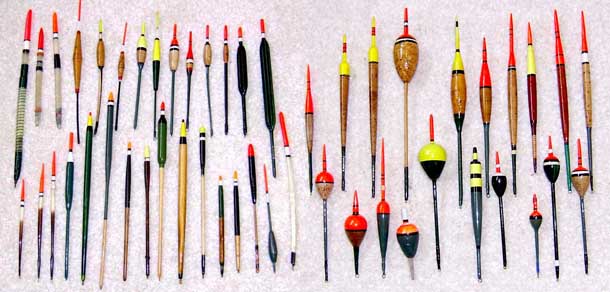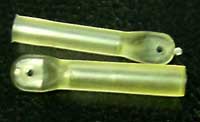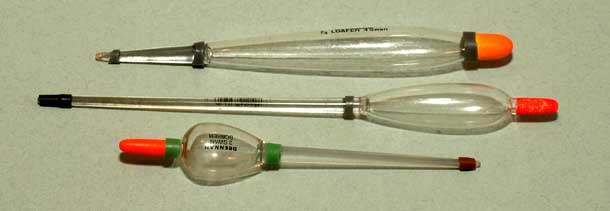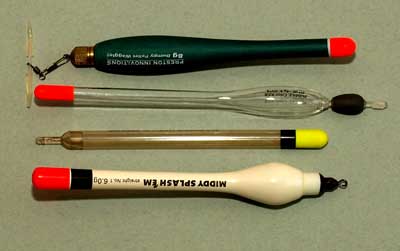Let’s clear up one small point about this series and this article in particular, it’s called “All You Need To Know” and not “All There Is To Know”. In other words, it’s not every scrap of knowledge that’s ever been written or is known about a subject, its just enough to help you make a sensible choice from what is currently available.

Saying that, I’d just like to show you this photograph of a collection of old floats that was recently sold on eBay by a chap called Wal Sewell. These floats don’t go back all that far in time, I can remember buying many like these in the 1960s and 70s. In fact some look so familiar they could be the same models as I owned, but the point is, they worked then, they would work now, only now we have standardised on two main types, the stick float for rivers, and the wagglers for rivers and stillwaters.
True there are floats for other purposes and a popular type are the pole floats, for use with long and margin pole fishing. There are also pike floats and carp controllers, but here, I’m more concerned with floats for general situations of coarse fishing.
Waggler Floats
Let’s start with the wagglers and named so because they are attached to your line at one end only, the bottom end where the eye is so that they can – waggle about. Where would we be without these now? There are straight wagglers, insert wagglers, bodied wagglers, and loaded wagglers, so let’s put some detail to them.

 Straight wagglers are made from one type of material, be that peacock quill, or sarcandas reed, or crystal plastic. They are usually the same diameter from top to bottom apart from the stubby bit that is attached to the line either by threading the line through it’s little hole or using a silicone float adaptor and pushing the stub into it. Using the adapter means that you can later change floats without breaking down all of your tackle.
Straight wagglers are made from one type of material, be that peacock quill, or sarcandas reed, or crystal plastic. They are usually the same diameter from top to bottom apart from the stubby bit that is attached to the line either by threading the line through it’s little hole or using a silicone float adaptor and pushing the stub into it. Using the adapter means that you can later change floats without breaking down all of your tackle.
For my own preference I like to use the peacock quills as I believe they fly through the air better having come from a bird anyway. However, there is a strong case for the crystal or clear plastic wagglers providing they are well made, but I tend to use these only in stillwaters even though I can’t qualify that choice. Sarcandas reed is very light, very buoyant, but hardly used in commercially available floats these days.

The insert waggler is very much like the straight waggler with the exception that the indication part, the bit that sticks above the water, is of a thinner and possibly different material. Being thinner there is less resistance to it floating making bite indication more positive, but at the same time more difficult to see at range. In some floats, particularly plastic ones, the insert part can be solid plastic and even less buoyant and easier for the fish to pull under since they can be almost as heavy as the water itself. In my view these are more sensitive to delicate bites.

Then there is the bodied waggler, named so because of the fatter body towards the bottom of the float. This enables the waggler to carry more shot so you can cast further or make the float more stable. At the upper end, some are straight, whilst others have insert tips and there are those that taper gradually, or stepping little by little towards the tip.
You will also find some like this that have a very tiny hole at the base, much smaller than on other wagglers that you could barely get a hair through and these are ‘sliders’. I think it was the late Billy Lane that came up with this idea (or it was him that told me about them anyway) for fishing really deep waters, 12 feet and more. The idea being the float is free to travel up and down the line for casting, but is stopped at the right depth by a fine sliding stop knot.

Loaded wagglers can be any of the above that have some weight added to the bottom already thereby saving you putting too much shot on the line. They can have fatter bodies, no bodies, insert tips or be straight. In some, the weight can be changed, swapped with other weights to allow you total control over how you wish to load the float with split shot.
Stick Floats.

Whereas the waggler can be fished on a river or stillwater, the stick float was designed for one purpose only – the river! (IMO) I think I would be correct in saying that Kevin and his father, Benny Ashurst had much to do with the popularisation, if not development, of the stick float. These are fixed to the line top and bottom by small rubber bands or caps as they’re often called.
Although most tend to follow one basic shape (see picture above) they do vary depending on the materials used in the making of them. The most basic form is the simple cane stemmed stick. The shape and length is decided more by the user than anything else.

Using the same shape is the lignum stick where the lower half is made from the much heavier wood, lignum vitae, and the top half balsa wood usually. The use of lignum wood gives more stability to the float as it is carried through the faster currents in the river. Also, because it is heavier and sinks in water, this type of float requires a little less shot size for size than the cane stick, but only marginally so if balanced correctly.

The next type is the alloy stemmed float. In this there is a departure in the shape, especially the top, which is usually made from balsa wood. Very light and buoyant at the top, but with a fine aluminium stem beneath it causing less resistance in the water. Because the aluminium is so dense, these are superb floats in very turbulent swims and used with skill give really fine control by the angler.

Another type that has hit the market in fairly recent years is one made of balsa at the top and a clear solid plastic stem beneath. I’m not sure whether Peter Drennan designed it (most likely he did), but it’s his company that now markets them as the Big Stick. They normally carry a fair bit of shot and have a highly visible tip to them, very useful when trotting the float at long range – 60 yards and more.
Other Types for Rivers

Top to Botttom, the loafer, the Avon, and a bobber for perch
Not too far from the stick floats in concept are the Avon and/or chub floats. Usually with a thin tip, thickening to a bulbous belly and then a finer stick to the bottom. The can be made from cane and balsa and even with the addition of a heavier wood or plastic for the stem. Then again, they can be plastic throughout with the belly being hollow. They take an awful lot of shot and are more suited to larger baits such as worms, prawns, slugs etc.

Another very similar type is the bodied crow quill float. A crow quill on its own can be a highly sensitive float indeed, but it doesn’t take a lot of shot and is therefore difficult to cast any distance and worse still control its path. Add a balsa body, similar to the Avon float, and it becomes a superb bite indicator on many rivers and different flows of water. The sad thing about these is that hardly anyone makes them any longer and they can be expensive.
Modern Adaptations of Wagglers
In recent times, the past 15 years or so, many new floats have been introduced with new names, but all, or most, are based on older basic designs.
For example, the Bagging Waggler. Based on the principles of a standard waggler but much fatter and with a built on groundbait frame, they are used to tempt match carp well up in the water. Attached by the bottom end only like other wagglers they are self-loaded and need no extra shot, although a small one can be pinched on the line just to sink the bait more quickly.
These floats are in popular use on some big reservoirs now like Clattercote and Drayton and in summer they appear to be the method to use. The idea being that upon hitting the water, the groundbait moulded around the base of the float disintegrates and falls down around the hookbait positioned some 18 inches to 3 feet deep. Carp, being greedy, grab at whatever solid food they can in the groundbait cloud grab the hookbait, usually a small 10mm boily or similar.
Another and even more recent adaptation is the Splashing Waggler and/or the Pellet Waggler. Both are intended to create a disturbance on the surface as they land thereby attracting the fish’s attention to the fact that food is arriving. Bait is almost always a banded pellet fished a couple of feet deep and the angler then catapults 4-6 similar sized pellets around the float at regular intervals.
Again, the idea is much the same as the Bagging Waggler in that it relies on the carp’s greed to grab at food before another fish can get it. A good Splashing or Pellet Waggler won’t travel too far beneath the surface before settling and many are self-loaded to begin with although not always so. Forms vary in shape from what look like strange mushrooms to just short fat normal straight wagglers and they too are attached bottom end only, by incredible contraptions in some cases (see picture).

The Polaris float is still very much like a waggler only the line is pushed through a small tube in a moulding at the bottom of the float. The bait is fished on the bottom with a running lead close to the hook (a form of float ledgering) and after casting the float rises to the surface where it is almost flat. You then tighten the line to the float until it sits with just the tip above the surface and takes are more often a lift or the float will disappear completely.
That’s not all there is to know, as I said at the beginning, but it is enough to allow you to make a respectable choice as to which float to purchase and what it is meant to do. I’m not going in to pike floats and controller floats or even pole floats just now. These will be covered in separate articles. For now, this has been a description of floats generally available at your store that will be useful in general type coarse fishing situations.
All You Need To Know – Swimfeeders
All You Need To Know – Quiver Feeder Rods











